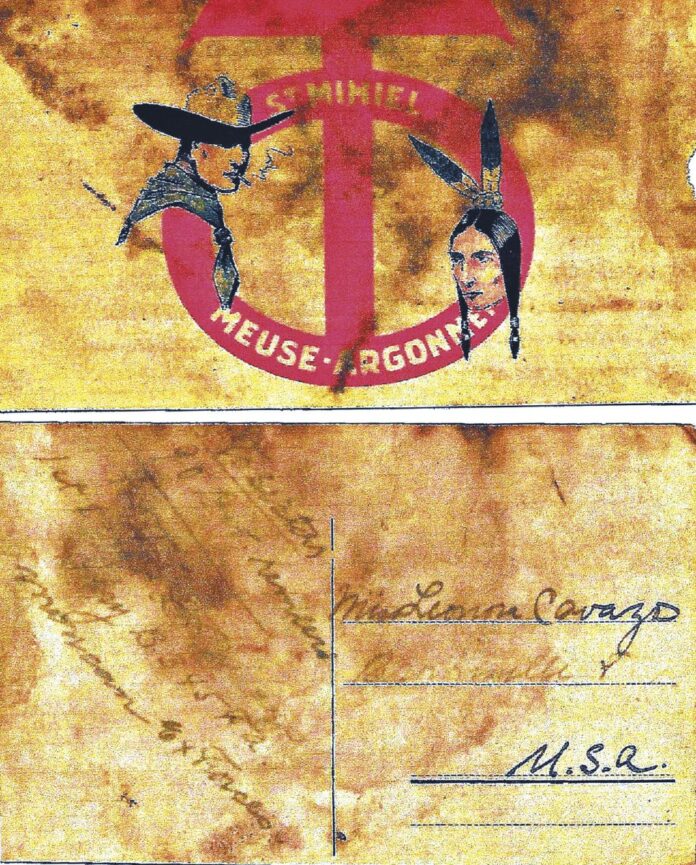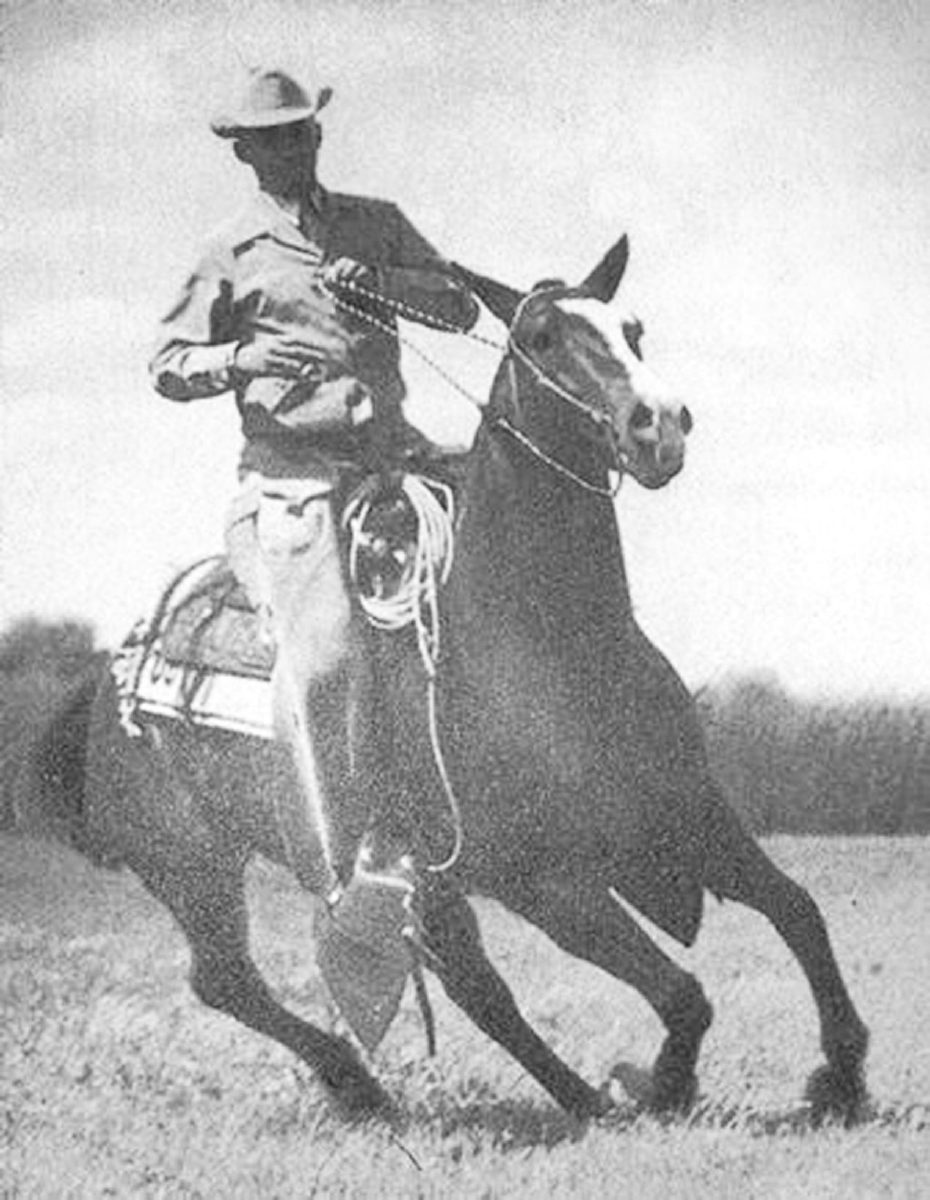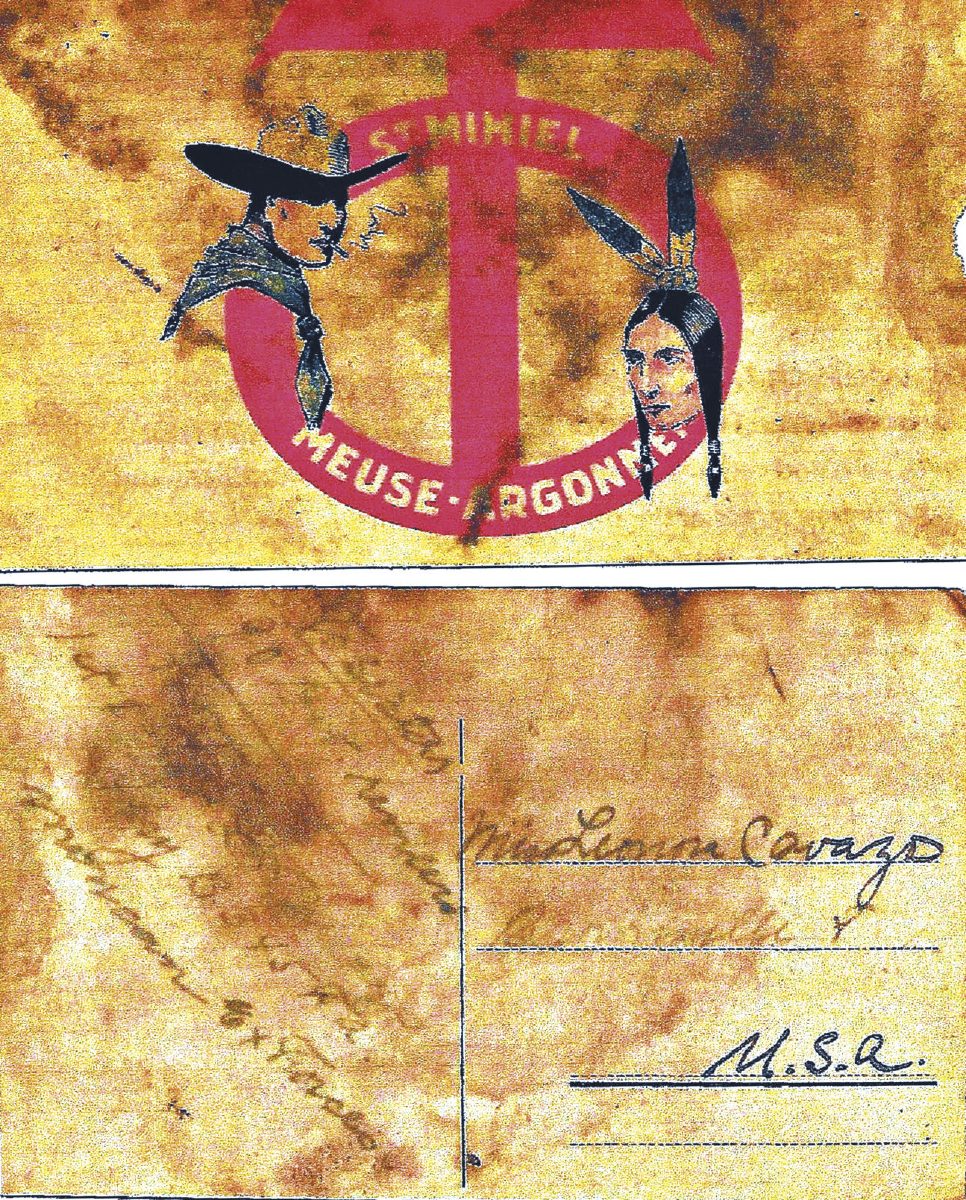BY NORMAN ROZEFF
Sometimes unexpected treasures and history can be uncovered in musty, long-neglected family collections. So it was when Charles Edward Wetegrove of Corpus Christi found a World War I post card among other family memorabilia while restoring the historic La Jarra Ranch (the old Las Majadas/Raymond Ranch homestead) east of Raymondville.
The card took both research and deciphering in order to learn its history and background. On the front is the stylized “TO” (tough ‘ombres” logo) with an Indian and a cowboy. Charles and I gleaned its sometimes illegible script [on the back] as “To Sisters 90 Dist. numbers from 1st Sargt L. Cavazos, Army B345 FA (Field. Artillery), America EX (Expeditionary) Forces (sic).
The addressee is Miss Leonora Cavazos of Brownsville Tex USA,who would become Charles’s maternal grandmother having married Edward Charles Raymond in 1922. Leonora was the oldest of Lauro’s three sisters.
On the top of the card is printed “St. Mihiel” while at the bottom is noted the battle of “Meuse-Argonne.”
From Wikipedia is noted:
The Battle of Saint-Mihiel was a major World War I battle fought from 12–15 September 1918, involving the American Expeditionary Force (AEF) and 110,000 French troops under the command of General John J. Pershing of the United States against German positions. The Air Service, U. S. Army (which later became the U.S. Air Force) played a significant role in this action. This battle marked the first use of the terms “D-Day and “H-Hour” by the Americans. The fighting was depicted in the 1927 silent film Wings (that went on to be awarded the first Best Picture Oscar in 1929.)
Meuse-Argonne was the climatic battle of WWI. At first German forces delayed an ill-organized advance to seize the Sedan-Mezières railroad, Germany’s main supply link, but after a re-ordering of allied forces the larger battle of the Meuse-Argonne was won, and the war drew to its end. Public school teacher Lenora [misspelled by the census taker as Lenara], who had received her Texas state teaching certificate in 1916, had protected her pupils near Santa Monica during the Mexican bandit raids and was age 30 when the 7th Justice Precinct U.S. Census was taken on February 11, 1920.
She was the oldest sibling still living at the farm home of her father, 56 year old Nicolas, and 48 year old mother Francisca. Also living at home were five working sons plus an adopted son and three additional daughters. Oldest son Lauro was serving in the U. S. Army at the time of this census. The entire family was Texas born and were descendants of the famed Cavazos land grant family.
In 1910 Nicolas had been a ranch hand according to the census of that year. In this, the 1910, census son Lauro was erroneously listed as daughter Laura, age 16.
Lauro is written up as follows in The Handbook of Texas Online, with added information in brackets:
CAVAZOS, LAURO FAUSTINO, SR. (1894-1958). Lauro F. Cavazos, Sr., King Ranch foreman and cowhand, was born on February 15, 1894, to Nicolás and Francisca (Garcia) Cavazos on the Laurel Ranch in present-day Willacy County. A descendant of José Narciso Cavazos (owner of the 1781 San Juan de Carricitos Spanish land grant) and third generation cowboy (Kineño) on the King Ranch, Cavazos attended school in Brownsville and then began work as a cowhand for Henrietta King in 1912. He was assigned to the Santa Gertrudis Division of the ranch where his jobs included riding fences, breaking horses, and herding and working cattle. He was transferred to the Norias Division of the King Ranch to work in a cow camp (or corrida) due to his skill on a horse. In 1915 he defended the King Ranch when it was attacked by Mexican raiders in the Norias Ranch Raid. The ranch hands were outnumbered by the raiders, and Cavazos’s actions during the gunfight included covering the wounded with mattresses, running from cover to fetch ammunition for the defenders, and shooting the horse out from under the raiders’ leader during a charge on the ranch. After the battle, he and another ranch hand were given the task of burying the bodies of ten bandits killed in the raid.
A picture taken by a reporter of Cavazos’s partner roping a dead body in order to carry it out to the sand dunes (where it was easily buried) caused a huge controversy in other parts of Texas and the nation because of the apparent lack of respect shown to the dead.
In May 1917 Cavazos traveled to enlist in the United States Army at a Brownsville recruiting station. He was eventually accepted and served in B Battery, 345th Field Artillery,Ninetieth Infantry Division, in three campaigns in France during World War I and rose to the rank of first sergeant. After the war, Cavazos was honorably discharged in 1919 and returned to work on the King Ranch as a part of the corrida of the Santa Gertrudis Division. Cavazos, after showing a strong work ethic and a desire to be more than a cowhand, was offered the position of foreman or cow boss on the Santa Gertrudis Ranch by Robert Kleberg, Jr.
Cavazos started to train for the position in 1920 and replaced Sam Ragland in 1926 as the foreman. After receiving the position (and the title ‘Don Lauro’ from the men who worked under him), Cavazos helped oversee the creation of a new breed of cattle fit to survive in the harsh, dry summers of South Texas’s Nueces Strip. By cross-breeding Brahman and Shorthorn cattle, Cavazos and Kleberg were able to create a new breed called Santa Gertrudis cattle. Cavazos raised his own herd of Santa Gertrudis cattle on a small ranch he owned near the town of Laurel on land that had once been a part of his ancestor’s Spanish land grant.
In 1923 Cavazos married Tomasa Alvarez Quintanilla [she was a descendant of Francita Alavez, the Angel of Goliad] and raised five children including: Sarita (who became a home economics teacher in Laredo), Richard (who became [the first Hispanic] four-star general in the U.S. Army), Lauro Jr. (who became president of Texas Tech University and the Secretary of Education under President Ronald Reagan), Bobby (who became a star high school and All-American college athlete [and foreman of the Laureles Division of the King Ranch]), and Joseph (a successful businessman). To ensure that his children received a strong education, Cavazos bought a lot in the Anglo portion of Kingsville so his children could attend the Anglo-only Flato Elementary School. Although initially reluctant because of prejudices against integrated schooling, the Kingsville ISD superintendent allowed Sarita and the rest of Cavazos’s children to attend Flato Elementary due to Cavazos’s work with the King Ranch. Cavazos’s efforts to make sure his children received a good education led them to find successful careers beyond the King Ranch that had previously not been available to Kineños and paved the way for others to follow in their footsteps.
Cavazos passed away at Spohn Hospital in Corpus Christi on November 30, 1958, from an illness related to cirrhosis of the liver. After a lifetime of work as a cowboy and foreman on the same land his ancestors worked, Cavazos was buried in the Rest Haven Memorial Gardens in Kingsville.
BIBLIOGRAPHY: Lauro F. Cavazos, A Kineño Remembers: From the King Ranch to the White House (College Station: Texas A&M University Press, 2006). Charles H. Harris III and Louis R Sadler, The Texas Rangers and the Mexican Revolution: The Bloodiest Decade, 1910–1920 (Albuquerque: University of New Mexico Press, 2004). Jorge Iber, “Mexican-Americans of South Texas Football: The Athletic and Coaching Careers of E.C. Lerma and Bobby Cavazos, 1932–1965,” The International Journal of the History of Sport 26 (May 2009), available online (http://www.tandfonline.com/doi/full/10.1080/09523360902826954#abstract), accessed March 26, 2011. Jane Clements Monday and Betty Bailey Colley, Voices from the Wild Horse Desert: The Vaquero Families of the King and Kenedy Ranches (Austin: University of Texas Press, 1997). Handbook of Texas Online, Joseph Fox, “Cavazos, Lauro Faustino, Sr.,” accessed January 24, 2017, http://www.tshaonline.org/handbook/online/articles/fcadu.
If nothing else, this story should encourage readers to pursue neglected family treasures in order to throw light on and augment family history.






